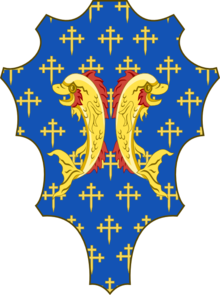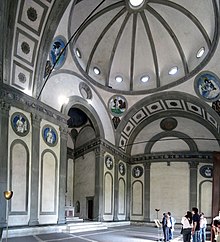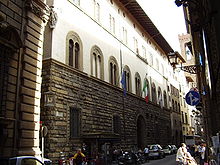Pazzi: Difference between revisions
m corrected Buonarotti in Buonarroti |
|||
| Line 66: | Line 66: | ||
The conspiracy is central to [[Ruggero Leoncavallo]]'s opera ''[[I Medici]]'', first performed on 9 November 1893.{{r|grove}} |
The conspiracy is central to [[Ruggero Leoncavallo]]'s opera ''[[I Medici]]'', first performed on 9 November 1893.{{r|grove}} |
||
It is the central story line of the novel Stone and Pain by [[Karel Schulz]] published in Czechoslovakia in 1942 as part of an unfinished trilogy based on life, time and work of Michelangelo |
It is the central story line of the novel Stone and Pain by [[Karel Schulz]] published in Czechoslovakia in 1942 as part of an unfinished trilogy based on life, time and work of Michelangelo Buonarroti.{{cn|date=April 2018}} |
||
==References== |
==References== |
||
Revision as of 06:53, 26 April 2018
| Pazzi | |
|---|---|
 | |
| Current region | Tuscany |
| Place of origin | Republic of Florence |
| Members |
|
The Pazzi were a noble Florentine family in the Middle Ages. In 1342 they gave up their titles of nobility so that members could be elected to public office.[citation needed] Their main trade during the 15th century was banking. In the aftermath of the Pazzi conspiracy in 1477, the family was banished from Florence and their property was confiscated; anyone named Pazzi had to take a new name.
History of the family
The traditional story is that the family was founded by Pazzo di Ranieri, first man over the walls during the Siege of Jerusalem of 1099, during the First Crusade, who returned to Florence with flints supposedly from the Holy Sepulchre, which were kept at Santi Apostoli and used on Holy Saturday to re-kindle fire in the city.[1][2]: 131 The historical basis of this legend has been in question since the work of Luigi Passerini Orsini de' Rilli in the mid-nineteenth century.[1]
The first apparently historical figure in the family is the Jacopo de' Pazzi who was a captain of the Florentine (Guelph) cavalry at the battle of Montaperti on 4 September 1260, and whose hand was treacherously severed by Bocca degli Abati, causing the standard to fall.[3]
Andrea de' Pazzi was the patron of the chapter-house for the Franciscan community at the Basilica of Santa Croce, Florence and commissioned construction of the Pazzi Chapel.
His son Jacopo de' Pazzi became head of the family in 1464.[2]: 131
Guglielmo de' Pazzi married Bianca de' Medici, sister of Lorenzo de' Medici, in 1460.[3]
Francesco de' Pazzi was one of the instigators of the Pazzi Conspiracy in 1477–78. He, Jacopo de' Pazzi and Jacopo's brother Renato de' Pazzi were executed after the plot failed.[2]: 141
Maria Maddalena de' Pazzi (1566–1607) was a Carmelite nun and mystic;[4]: 218 she was canonised in 1669.[5]: 149
Pazzi Chapel

The Pazzi Chapel was designed by Filippo Brunelleschi. Construction began in 1442 in a cloister of the Franciscan church of Santa Croce. The High-Renaissance design is restrained and sober, using pietra serena and white plaster in geometric designs, generally unrelieved by colour, and capped with a hemispherical dome, completed after Brunelleschi's death according to his plans.
Palaces in Florence

- Palazzo Pazzi (Palazzo Pazzi-Quaratesi): The main seat of the family, at canto Pazzi, where Borgo degli Albizi crosses via del Proconsolo, was commissioned by Jacopo de' Pazzi, and built circa 1462–72 to designs by Giuliano da Maiano. Above its traditionally rusticated ground floor of the yellow-ochre sandstone, it had a then-novel stuccoed first and second floor, with delicate designs in the windows influenced by Brunelleschi. The central court is surrounded on three sides by round-headed arcading, with circular bosses in the spandrels.
- Palazzo Pazzi Ammannati: a smaller palace in the Borgo degli Albizi, between Palazzo Ramirez de Montalvo and the Palazzo Nonfinito. It houses a section of the Museum of Natural History of Florence, and hosts temporary exhibitions. The façade is attributed to Bartolomeo Ammannati.
Pazzi Conspiracy
Early in 1477 Francesco de' Pazzi, manager in Rome of the Pazzi bank, plotted with Girolamo Riario, nephew and protegé of the pope, Sixtus IV, and with Francesco Salviati, whom Sixtus had made archbishop of Pisa, to assassinate Lorenzo de' Medici and his brother Giuliano to oust the Medici family as rulers of Florence.[2]: 131 Sixtus gave tacit support to the conspirators.[6]: 254 The assassination attempt was made during mass in the Duomo of Florence on 26 April 1478. Giuliano was killed; Lorenzo was wounded but escaped.[6]: 254–255 Salviati, with mercenaries from Perugia, tried but failed to take over the Palazzo della Signoria.[2]: 138 Most of the conspirators were soon caught and summarily executed; five, including Francesco de' Pazzi, were hanged from the windows of the Palazzo della Signoria.[2]: 140 Jacopo de' Pazzi, head of the family, escaped from Florence but was caught and brought back. He was tortured, then hanged from the Palazzo della Signoria next to the decomposing corpse of Salviati. He was buried at Santa Croce, but the body was dug up and thrown into a ditch. It was then dragged through the streets and propped up at the door of Palazzo Pazzi, where the rotting head was mockingly used as a door-knocker. From there it was thrown into the Arno; children fished it out and hung it from a willow tree, flogged it, and then threw it back into the river.[2]: 141
The Pazzi were banished from Florence, and their lands and property confiscated. Their name and their coat of arms were perpetually suppressed. The name was erased from public registers, and all buildings and streets carrying it were renamed. Their shield with its dolphins was obliterated. Anyone named Pazzi had to take a new name; anyone married to a Pazzi was barred from public office.[2]: 142 Guglielmo de' Pazzi, husband of Lorenzo's sister Bianca, was merely placed under house arrest.[2]: 141
After the overthrow of Piero de' Medici in 1494, the Pazzi family, and many other political exiles, returned briefly to Florence to participate in the restored republic.[citation needed]
Cultural depictions
The conspiracy is the subject of La congiura de' Pazzi, a play by Vittorio Alfieri first performed in 1787 and published in 1789, and of a historical novel by Lorenzo Antonini from 1877 with the same title.[citation needed]
The conspiracy is central to Ruggero Leoncavallo's opera I Medici, first performed on 9 November 1893.[7]
It is the central story line of the novel Stone and Pain by Karel Schulz published in Czechoslovakia in 1942 as part of an unfinished trilogy based on life, time and work of Michelangelo Buonarroti.[citation needed]
References
- ^ a b Arnaldo D'Addario (1970). Pazzi (in Italian). Enciclopedia Dantesca. Rome: Istituto dell'Enciclopedia Italiana. Accessed October 2015.
- ^ a b c d e f g h i Christopher Hibbert (1979 [1974]). The Rise and Fall of the House of Medici. Harmondsworth, Middlesex: Penguin. ISBN 0140050906.
- ^ a b Claudia Tripodi (2015). Pazzi, Guglielmo de' (in Italian). Dizionario Biografico degli Italiani, volume 82. Rome: Istituto dell'Enciclopedia Italiana. Accessed October 2015.
- ^ Clare Copeland (2016). Maria Maddalena De' Pazzi: The Making of a Counter-Reformation Saint. Oxford: Oxford University Press. ISBN 9780198785385.
- ^ Joseph Hammond (2012). An Old Altarpiece for a New Saint: The Canonization of Santa Maria Maddalena de' Pazzi and the Decoration of Santa Maria dei Carmini in Venice. Explorations in Renaissance Culture 38 (1-2): 149–169. doi:10.1163/23526963-90000431. ISSN 0098-2474. (subscription required).
- ^ a b Vincent Cronin (1992 [1967]). The Florentine Renaissance. London: Pimlico. ISBN 0712698744.
- ^ Michele Girardi. Medici, I. In: Stanley Sadie (ed.) The New Grove Dictionary of Opera. Grove Music Online. Oxford Music Online. Oxford University Press. Accessed May 2015. (subscription required).
